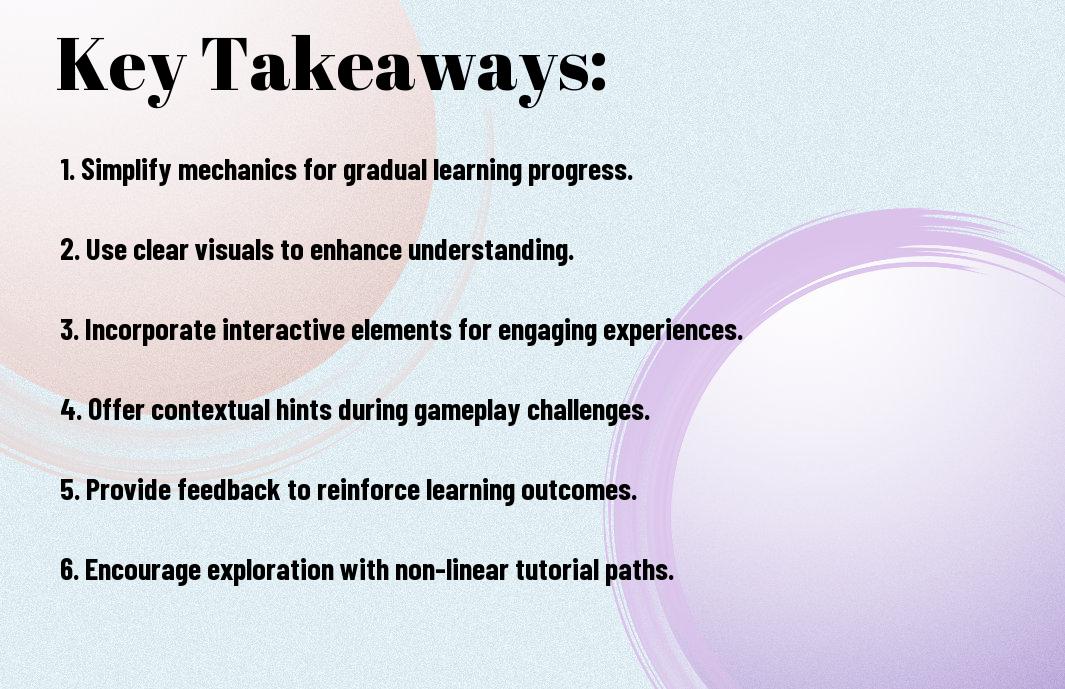As you develop your game, you want to ensure that new players can easily navigate its complex mechanics. You understand that a well-designed tutorial is crucial to keeping players engaged. Your goal is to create an introduction that is both intuitive and informative, setting your players up for success. By crafting a thoughtful and well-structured tutorial, you can help your players build confidence and develop the skills they need to fully enjoy your game.

Key Takeaways:
- Introduce game mechanics gradually, allowing players to absorb and understand each element before adding more complexity to prevent overwhelm and frustration.
- Use interactive tutorials that let players learn by doing, rather than passive tutorials that only provide information, to increase engagement and retention.
- Make tutorials concise and to the point, avoiding unnecessary information that might confuse or distract new players from the main gameplay.
- Provide clear and consistent feedback to players during tutorials, helping them understand what they are doing correctly or incorrectly and how to improve.
- Use visual cues, such as highlighted buttons or on-screen prompts, to guide players through tutorials and draw attention to important elements.
- Test tutorials with real players to identify areas of confusion or difficulty and make adjustments to improve the learning experience.
- Consider using optional advanced tutorials or tips for experienced players, allowing them to skip basic information and dive deeper into the game’s mechanics and strategies.
Core Principles of Tutorial Design
A well-designed tutorial is crucial for easing new players into complex games, and you should consider several key factors when creating your tutorial, including the player’s experience and the game’s mechanics.
Progressive Complexity Layers
With each new concept introduced, you will be able to build upon previous knowledge, allowing your players to gradually absorb the game’s complexity and deepen their understanding of the mechanics.
Reward-Based Learning Steps
Steps to implement reward-based learning include setting clear goals and providing incentives for achieving them, which will help your players stay motivated and engaged throughout the tutorial.
Also, as you design your reward-based learning steps, you will want to ensure that the rewards are meaningful and relevant to the player’s progress, providing a sense of accomplishment and encouraging them to continue learning and improving their skills.

Player Psychology in Learning
Even when designing tutorials, you should consider the psychological aspects of learning, as this will help you create a more effective and engaging experience for your players. You can learn more about Creating Positive User Experiences When Introducing Players to Your Game to improve your tutorial design.
Cognitive Load Management
Across various studies, it has been shown that managing cognitive load is vital for effective learning, and you can apply this principle to your tutorial design by breaking down complex information into manageable chunks, allowing your players to absorb and process the information more easily.
Motivation and Achievement Patterns
Any well-designed tutorial should also take into account the motivation and achievement patterns of your players, as this will help you create a sense of progression and accomplishment, keeping your players engaged and motivated throughout the learning process.
Understanding what motivates your players and how they respond to achievements is key to designing an effective tutorial. You can use this knowledge to create a sense of progression and accomplishment, providing your players with a sense of pride and satisfaction as they complete each level or achieve specific goals, which will keep them engaged and motivated to continue playing and learning.
Interactive Teaching Elements
Keep your tutorials engaging with interactive elements that encourage participation and learning. You can use quizzes, puzzles, or challenges to test your players’ understanding and provide a sense of accomplishment.
Contextual Help Systems
Intuitively, you can design help systems that provide relevant information at the right time, reducing frustration and guiding your players through complex gameplay mechanics.
Dynamic Feedback Mechanisms
The key to effective learning is providing timely and relevant feedback, allowing you to adjust your approach and improve your skills, and you can achieve this by incorporating dynamic feedback mechanisms into your tutorials.
Teaching through dynamic feedback mechanisms involves providing your players with immediate feedback on their actions, helping you to identify areas where they need improvement and adjust your tutorial accordingly, ensuring that your players stay engaged and motivated throughout the learning process, and you can use various techniques such as visual cues, audio feedback, or even gentle nudges to guide your players in the right direction.
Tutorial Pacing Structures
All well-designed tutorials have a pacing structure that eases new players into complex games, and you should consider this when creating your own. You want to ensure that your players are engaged and learning at a comfortable pace, without feeling overwhelmed or bored.
Milestone-Based Progression
Any successful tutorial will use milestone-based progression to guide players through the game, and you can achieve this by setting clear goals and objectives for your players to complete. You will find that this approach helps to create a sense of accomplishment and motivation, as players progress through the game.
Skill Gate Implementation
By implementing skill gates, you can control the flow of information and ensure that players have mastered the necessary skills before progressing to more complex content. You can use this technique to prevent players from becoming frustrated or stuck, and to create a more enjoyable learning experience.
Further implementation of skill gates involves careful consideration of your game’s mechanics and the skills required to progress. You will need to identify the key skills that players must master, and design gates that test these skills in a fair and challenging way, allowing you to create a tutorial that is both effective and engaging for your players.
Visual and Audio Guidance
For effective onboarding, you can leverage visual and audio cues to guide new players. You can learn more about this by checking out the tips on How to Design Games for New Players: Tips and Principles, which will help you create an engaging experience.
Interface Element Highlighting
With intuitive interface design, you can draw attention to key elements, making it easier for new players to navigate your game. You can use visual effects, such as animations or highlights, to guide their focus.
Sensory Learning Cues
Elementary sensory cues, like sound effects or vibrations, can enhance the learning experience, providing feedback and reinforcement as players progress through your game.
Interface design plays a significant role in sensory learning cues, as you can use a combination of visual, audio, and haptic feedback to create an immersive experience, helping new players understand the game mechanics and interact with your game world more effectively, making it easier for you to design engaging tutorials.
Testing and Iteration Methods
To ensure your tutorials are effective, you need to test them with real players and iterate on the design based on the feedback and results you receive.
Player Behavior Analysis
Behaving as a player would, you can analyze how users interact with your tutorial, identifying areas where they get stuck or lose interest, allowing you to make targeted improvements.
Tutorial Effectiveness Metrics
At the core of evaluating your tutorial’s success are metrics that measure player engagement, retention, and overall understanding of the game mechanics, which you can use to refine your design.
Also, by tracking these metrics, you can determine which parts of the tutorial are most effective and which need revision, enabling you to create a more streamlined and efficient learning experience for your players, ultimately enhancing their overall enjoyment of the game.
Summing up
So, as you design tutorials for complex games, you will find that your approach has a significant impact on the player’s experience. You can ease new players into the game by introducing mechanics gradually, providing clear instructions, and offering feedback. By doing so, you create an engaging and enjoyable experience, helping your players build confidence and develop the skills needed to progress through the game, making your tutorial a valuable asset to your overall game design.
FAQ
Q: What is the primary goal of designing perfect tutorials for complex games?
A: The primary goal of designing perfect tutorials is to create an engaging and intuitive experience that eases new players into the game, helping them understand the mechanics, rules, and objectives without feeling overwhelmed or frustrated. A well-designed tutorial should provide a gentle learning curve, allowing players to build confidence and develop the skills necessary to enjoy the game to its fullest potential. By doing so, developers can increase player retention, improve overall satisfaction, and encourage players to continue playing and exploring the game.
Q: How can game developers balance the need to teach complex gameplay mechanics with the risk of overwhelming new players?
A: To balance the need to teach complex gameplay mechanics with the risk of overwhelming new players, game developers can use a variety of techniques, such as breaking down complex mechanics into smaller, manageable chunks, and introducing them gradually through a series of interactive lessons or challenges. Additionally, developers can use visual cues, audio feedback, and subtle hints to guide players through the learning process, rather than relying on lengthy text-based instructions or dry tutorials. By using a combination of these approaches, developers can create a tutorial experience that is both informative and engaging, allowing players to learn at their own pace and develop a deep understanding of the game’s mechanics.
Q: What role does player feedback and testing play in the design of effective tutorials for complex games?
A: Player feedback and testing play a vital role in the design of effective tutorials for complex games. By testing the tutorial with a diverse group of players and gathering feedback on their experiences, developers can identify areas where the tutorial may be confusing or overwhelming, and make targeted improvements to address these issues. This can involve refining the pacing and content of the tutorial, adjusting the level of difficulty, or adding additional guidance and support to help players overcome specific challenges. By iterating on the tutorial design based on player feedback, developers can create a more effective and enjoyable learning experience that meets the needs of new players and helps them to succeed in the game.



